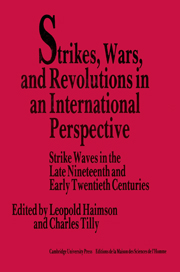 Strikes, Wars, and Revolutions in an International Perspective
Strikes, Wars, and Revolutions in an International Perspective Book contents
- Frontmatter
- Contents
- List of contributors
- Preface
- Part I Introductions
- Part II Models and realities
- Part III Workers in metal-processing enterprises in comparative perspective
- 11 From the mechanic to the metallo
- 12 Strikes of machinists in the United States, 1870–1922
- 13 The political economy of British engineering workers during the First World War
- 14 The rationalization of class struggle: strikes and strike strategy of the German Metalworkers' Union, 1891–1922
- 15 Scientific management and the changing nature of work in the St. Petersburg metalworking industry, 1900–1914
- 16 Structural processes of change and changing patterns of labor unrest: the case of the metal-processing industry in Imperial Russia, 1890–1914
- 17 Social characteristics, attitudes, and patterns of strike behavior of metalworkers in Italy during the First World War
- Part IV The effects of short-term variation
- Part V Conclusion
12 - Strikes of machinists in the United States, 1870–1922
Published online by Cambridge University Press: 25 March 2010
- Frontmatter
- Contents
- List of contributors
- Preface
- Part I Introductions
- Part II Models and realities
- Part III Workers in metal-processing enterprises in comparative perspective
- 11 From the mechanic to the metallo
- 12 Strikes of machinists in the United States, 1870–1922
- 13 The political economy of British engineering workers during the First World War
- 14 The rationalization of class struggle: strikes and strike strategy of the German Metalworkers' Union, 1891–1922
- 15 Scientific management and the changing nature of work in the St. Petersburg metalworking industry, 1900–1914
- 16 Structural processes of change and changing patterns of labor unrest: the case of the metal-processing industry in Imperial Russia, 1890–1914
- 17 Social characteristics, attitudes, and patterns of strike behavior of metalworkers in Italy during the First World War
- Part IV The effects of short-term variation
- Part V Conclusion
Summary
The most impressive fact about machinists' strikes in the late nineteenth century is that there were not many of them. Strike statistics published by the U.S. Commissioner of Labor in 1887 and in 1896 classified strikers by occupation (in contrast to the famous report of 1906 that arranged all strikes since 1881 according to the industries involved). Strikes by coal miners, building workers, clothing workers, iron-and-steelworkers, and printers appeared frequently in the early figures, but not those of machinists. Work stoppages that did close metal fabricating establishments were regularly attributed to molders, and less often to boilermakers and to blacksmiths. Of fifty strikes in Pittsburgh's metal industry (excluding iron and steel smelting and rolling) during 1886, for example, not one was credited to machinists. Moreover, the machinists' strikes that did stand out were largely conducted by members of the craft who worked in railroad repair shops. Large manufacturers of railway cars in Detroit, Pullman, Paterson, and elsewhere were often struck in the 1880s, but most of their employees were woodworkers of some sort. In them – as in the San Francisco shipyards, Connecticut hardware factories, and midwestern agricultural implement works, where important strikes took place before 1894 – machinists left their posts along with others, but there is no hint of any special or leading role they might have played. If any single craft acted constantly and aggressively as a craft in nineteenth-century metalworks, it was the iron molders.
In 1922 the Department of Labor again released data that attributed strikes to particular crafts or occupations, and the figures covered the years 1916–21.
- Type
- Chapter
- Information
- Strikes, Wars, and Revolutions in an International PerspectiveStrike Waves in the Late Nineteenth and Early Twentieth Centuries, pp. 269 - 288Publisher: Cambridge University PressPrint publication year: 1989
- 1
- Cited by
